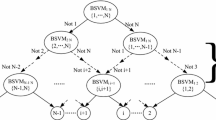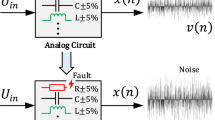Abstract
As numerous faults exist in practical analog circuits, new challenges arise in the field of diagnosis with large-scale target faults as well as fault features. To address this issue, firstly, an ambiguity model is built to measure the distinguishability between two faults. Then, the optimal fault features are obtained by analyzing the response curves of the circuit under test (CUT) to minimize the ambiguities among the faults. Finally, comparisons are made among three classification methods, including the maximum likelihood classifier (MLC), artificial neural networks (ANNs) and support vector machine (SVM), to demonstrate their own diagnostic abilities for practical use. Two examples are illustrated, and taking advantage of an automated implementation framework, 92 faults in total are examined in the second example. The experimental results show that good diagnostic performances can be obtained with the proposed method. However, when a practical case is encountered, the ANNs method may fail due to its high time and space complexity, while the MLC and SVM methods are still applicable.






Similar content being viewed by others
References
Alippi C, Catelani M, Fort A, Mugnaini M (2002) SBT soft fault diagnosis in analog electronic circuits: a sensitivity-based approach by randomized algorithms. IEEE Trans Instrum Meas 51(5):1116–1125
Aminian M, Aminian F (2000) Neural-network based analog-circuit fault diagnosis using wavelet transform as preprocessor. IEEE Trans Circuits Syst II, Analog Digit Signal Process 47(2):151–156
Ao YC, Shi YB, Zhang W, Li YJ (2013) An approximate calculation of ratio of normal variables and its application in analog circuit fault diagnosis. J Electron Test 29(4):555–565
Bowman AW (1984) An alternative method of cross-validation for the smoothing of density estimates. Biometrika 71(2):353–360
Catelani M, Fort A (2000) Fault diagnosis of electronic analog circuits using a radial basis function network classifier. Measurement 28(3):147–158
Cui J, Wang YR (2011) A novel approach of analog circuit fault diagnosis using support vector machines classifier. Measurement 44(1):281–289
Deng Y, Shi YB, Zhang W (2012) An approach to locate parametric faults in nonlinear analog circuits. IEEE Trans Instrum Meas 61(2):358–367
Gao C, Huang JY, Sun Y, Diao SL (2012) Particle swarm optimization based RVM classifier for non-linear circuit fault diagnosis. J Cent South Univ 19:459–464
Han H, Wang HJ, Tian SL, Zhang N (2013) A new analog circuit fault diagnosis method based on improved mahalanobis distance. J Electron Test 29(1):95–102
Haykin S (2009) Neural networks and learning machines, third edition. Pearson Education, Upper Saddle River
Hu M, Wang H, Hu G, Yang SY (2007) Soft fault diagnosis for analog circuits based on slope fault feature and BP neural networks. Tsinghua Sci Technol 12:26–31
Huang K, Stratigopoulos HG, Mir S (2010) Bayesian fault diagnosis of RF circuits using nonparametric density estimation. Proc IEEE Asian Test Symp:295–298
Huang K, Stratigopoulos HG, Mir S, Hora C, Xing YZ, Kruseman B (2012) Diagnosis of local spot defects in analog circuits. IEEE Trans Instrum Meas 61(10):2701–2712
Jia Y, Harman M (2011) An analysis and survey of the development of mutation testing. IEEE Trans Softw Eng 37(5):649–678
Jones MC, Marron JS, Sheather SJ (1996) A brief survey of bandwidth selection for density estimation. J Am Stat Assoc 91(433):401–407
Kumar A, Singh AP (2013) Fuzzy classifier for fault diagnosis in analog electronic circuits. ISA Trans 52 (6):816–824
Litovski V, Andrejević M, Zwolinski M (2006) Analogue electronic circuit diagnosis based on ANNs. Microelectron Reliab 46(8):1382–1391
Luo H, Wang YR, Cui J (2011) A SVDD approach of fuzzy classification for analog circuit fault diagnosis with FWT as preprocessor. Expert Syst Appl 38(8):10554– 10561
Luo H, Wang YR, Lin H, Jiang YY (2012) Module level fault diagnosis for analog circuits based on system identification and genetic algorithm. Measurement 45(4):769–777
Luo H, Wang YR, Lin H, Jiang YY (2012) A new optimal test node selection method for analog circuit. J Electron Test 28(3):279–290
Sarathi Vasan AS, Long B, Pecht M (2013) Diagnostics and prognostics method for analog electronic circuits. IEEE Trans Ind Electron 60(11):5277–5291
Tan H, Peng MF (2012) Minimization of ambiguity in parametric fault diagnosis of analog circuits: A complex network approach. Appl Math Comput 219(1):408–415
Taylor CC (1989) Bootstrap choice of the smoothing parameter in kernel density estimation. Biometrika 76 (4):705–712
Xie T, He YG (2014) Fault diagnosis of analog circuit based on high-order cumulants and information fusion. J Electron Test 30(5):505–514
Xu AQ, Tang XF, Yang ZY (2014) Mutant generation for analog circuit designs. Proc IEEE Inter Conf Soft Eng Service Sci:916–920
Yuan LF, He YG, Huang JY, Sun YC (2010) A new neural-network-based fault diagnosis approach for analog circuits by using kurtosis and entropy as a preprocessor. IEEE Trans Instrum Meas 59(3):586–595
Acknowledgments
This work has been supported by the Nature Science Foundation of China (NSFC) (No.61473306), Taishan Scholars Program of Shandong Province, China.
Author information
Authors and Affiliations
Corresponding author
Additional information
Responsible Editor: H.-G. Stratigopoulos
Rights and permissions
About this article
Cite this article
Tang, X., Xu, A. Practical Analog Circuit Diagnosis Based on Fault Features with Minimum Ambiguities. J Electron Test 32, 83–95 (2016). https://doi.org/10.1007/s10836-015-5561-1
Received:
Accepted:
Published:
Issue Date:
DOI: https://doi.org/10.1007/s10836-015-5561-1




